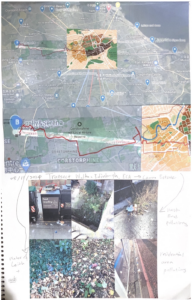WEEK9-Designing for a Sustainable Future
Capitalism and Environment
In the design world, our creative efforts are not isolated fantasies, but are closely tied to the global environment and the political forces that shape it. Designers are global citizens and creators who have a responsibility to consider the impact of their work on the environment and sustainable development efforts.
The concept of the Anthropocene requires recognition of our important role as geological agents, changing the planet through our actions. This recognition transforms design from being just a profession to a central player in the story of environmental change. Our work builds on foundational research that explores the dynamics of human nature, such as Crutzen and Stormer’s “Anthropocene Discourse” and “Capitalocene Discourse”, which highlight the role of capitalism in environmental destruction.
From my personal perspective and in a wider context, I see my design practice as a catalyst for change, and I believe in the ecological design principles developed by van der Leyen and Cowan, which we strive to adhere to below. Their five principles provide me with guidance in developing environmentally sustainable solutions that work in harmony with nature, engage all designers, and care about nature.
Design, Climate and Responsibilities
The Flood is the culmination of a three-year collaboration between co-writers and directors Fisher Stevens and Leonardo Dicaprio, exploring the devastating effects of climate change. The documentary explores humanity’s ability to overcome the most difficult challenges. This highlights the interconnectedness of the global climate and the urgency of our situation. DiCaprio and Stevens bring a sense of urgency to communities by proposing practical solutions, such as a carbon tax to shift investment toward renewable energy and cutting subsidies to fossil fuel companies. They emphasize the need for political engagement, urging voters to support leaders who value science and the scientific process, and warning corporate interests against resistance to climate action.
My work as a designer and global citizen reflects my commitment to the environment. My design philosophy is to respond to the political ecology around us, advocating for designs that are not only visually appealing but also environmentally friendly. This requires careful self-reflection on the development of your field and your place in it to ensure that your contributions help build a more sustainable and just world.

Figure 1: Transect Walk, Sally Li, 2024
In summary, as designers, we have a responsibility to express ideas and critical thinking in a variety of creative ways: verbally, visually, and in writing. Our mission is more than just creativity. It is about shaping a future that is in harmony with the environment and respects the political ecology in which we live. Through this lens, we can fully understand our ability to shape a richer world.
bibliography
IGBP (2015). Anthropocene – IGBP. [online] Igbp.net. Available at: http://www.igbp.net/globalchange/anthropocene.4.1b8ae20512db692f2a680009238.html [Accessed 12 Nov. 2024].
Moore, J.W. (2015). Capitalism in the web of life : ecology and the accumulation of capital. London ; New York: Verso.
Van and Cowan, S. (1996). Ecological Design. [online] Island Press. Available at: https://books.google.co.uk/books/about/Ecological_Design.html?id=7UQfsbumtzUC&redir_esc=y [Accessed 11 Nov. 2024].
Figure 1 is my own work.